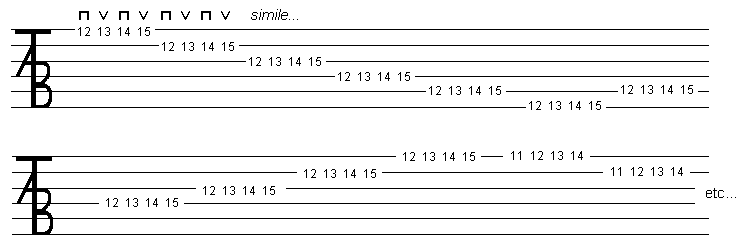
Good picking technique is vital if you want to be able to play quickly and accurately. Some people would argue that the days of the monster shredders has passed, but if you listen around, there's still a lot of fast guitar playing going on. Even if shredding isn't your thing, there's still a good chance that you could benefit from refining your picking technique - when your left and right hands are working together correctly you have much more control over what you're playing.
There are two important things to remember here. Firstly, using alternate picking with your right hand, and having the fingers of the left hand moving perfectly in synch with the right hand.
By alternate picking, I mean that you should be using strict down and up strokes. Obviously, sometimes when you're playing there'll be times that you need to really dig in and emphasis certain notes and at times like that a few consective downstokes would be OK, but for the sort of playing that we're talking about here every downstroke should be followed by up stroke with the pick.
The following example is fairly straight forward. Basically you're repeating the same 4-note pattern over all six strings from the top E, down to the bottom E and then back up to the top E again. Once you finish playing that pattern, move the whole thing down by one fret and repeat the cycle. Keep this going until you get down to the bottom end of the neck.
Notice the symbols marked above the tab - these denote the picking direction for your right hand. The squared-off symbol means a downstoke, the v-shaped one means an upstroke. Stick to this picking pattern throughout, and make sure that it's nice and even (each note lasting as long as the others, and no pauses between them). If you can't keep the picking even, then you're probably trying to go too fast, so slow the pace down until you can do it - a metronome is a superb piece of kit to have around for this sort of exercise.
As you become more proficient you should be able to step the pace up but still keep things sounding smooth. If you've been practising, then your two hands should be working in synch with each other, and because the right hand pattern is strict alternate picking, it's a lot easier to speed up than a more erratic pattern of down and up strokes.
There are loads of combinations of this that you can play. The first set of variations involve changing the pattern of notes that you play. Instead of the 1-2-3-4 pattern used in the last example, you could play 4-3-2-1, 1-3-2-4, and so on. A second variation that you can use is to play the same thing but only using pairs of strings, or just a single string.
Obviously going through all the combinations will take way longer than you can probably justify spending - even if your technique is really sloppy, there are other things that you'll probably want to practise. Anyway, this sort of exercise is, to be perfectly honest, pretty tedious. It may help to have a good picking 'workout' once a week (or a bit more often if you're trying to sort out some flaws in your technique) and maybe just use a few of these exercises as part of your warm-up or for an occaisonal bit of variety in your daily practise routine.
One final word of warning - it is possible to work at these exercises too hard. If you find that your left hand starts to hust after playing for a while, ease up and have a rest. If you play these exercises for a long time you risk straining your hand and doing yourself some damage - remember to train, but don't strain.
How useful did you find this tutorial?